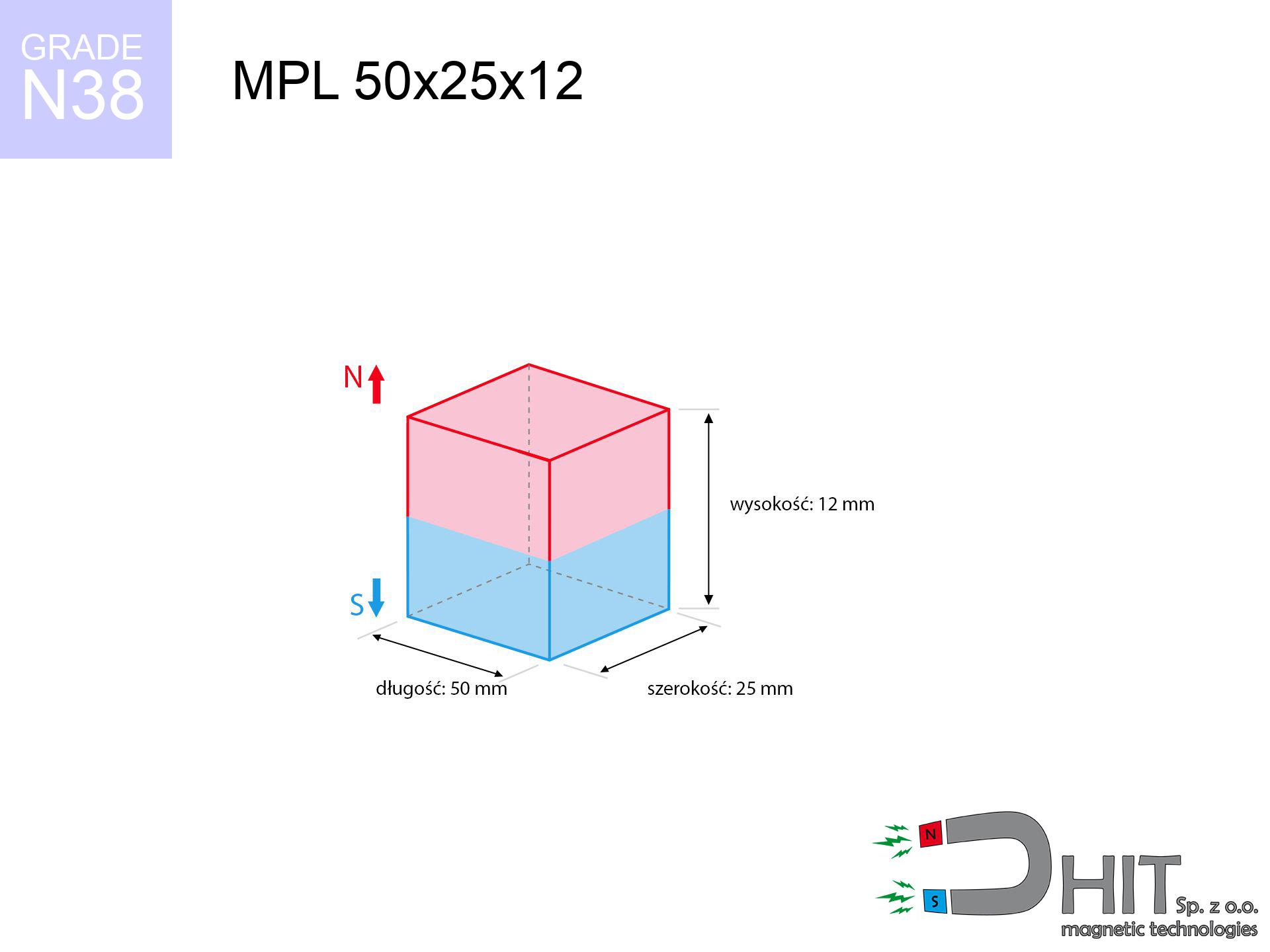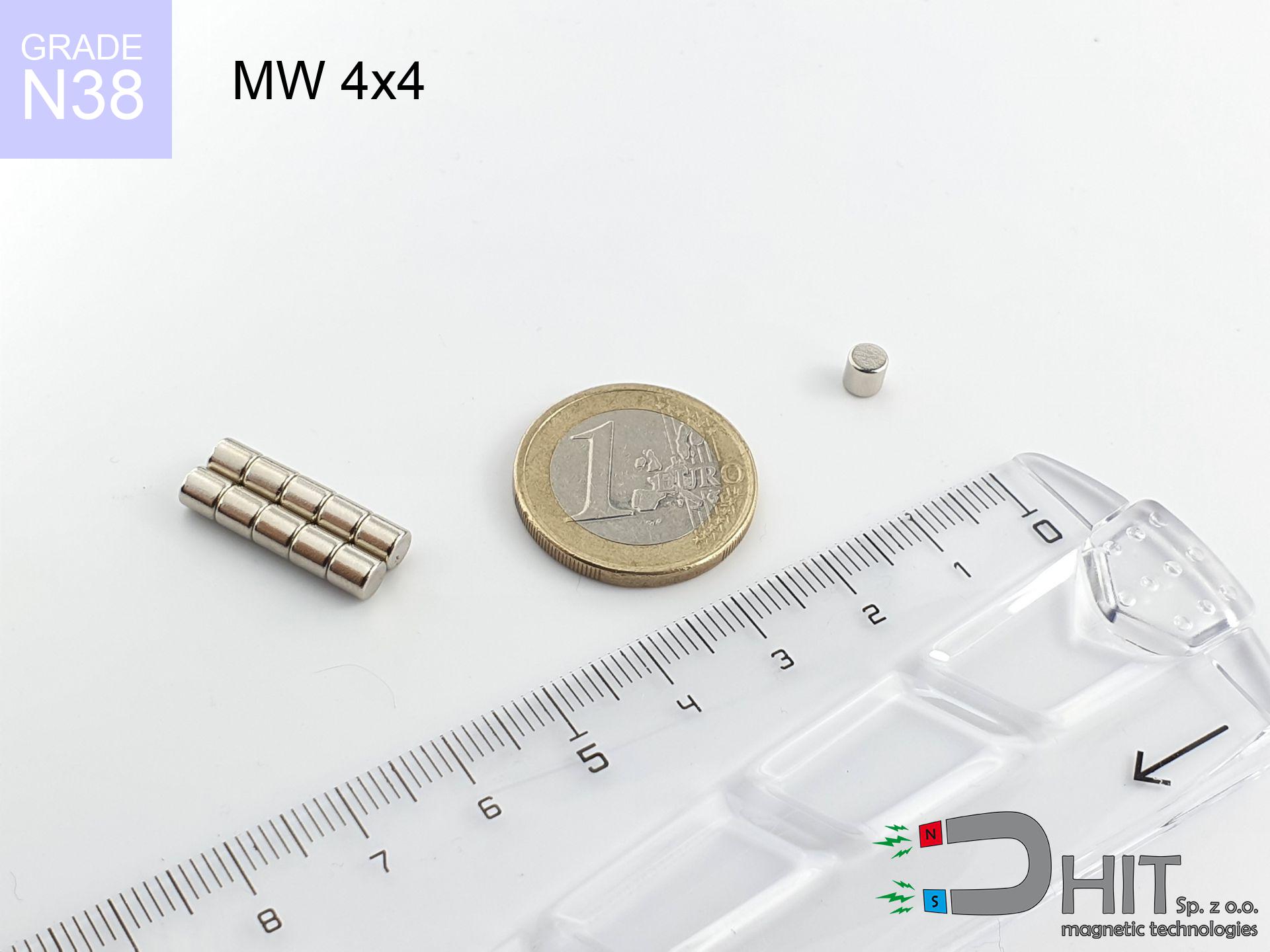MPL 50x25x12 / N38 - neodymium magnet
lamellar magnet
catalog number 020343
GTIN: 5906301811855
length
50
mm [±0,1 mm]
width
25
mm [±0,1 mm]
height
12
mm [±0,1 mm]
magnetizing direction
↑ axial
capacity ~
33.50 kg / 328.52 N
magnetic induction ~
340.43 mT / 3,404 Gs
max. temperature
≤ 80
°C
catalog number 020343
GTIN: 5906301811855
length
50 mm [±0,1 mm]
width
25 mm [±0,1 mm]
height
12 mm [±0,1 mm]
magnetizing direction
↑ axial
capacity ~
33.50 kg / 328.52 N
magnetic induction ~
340.43 mT / 3,404 Gs
max. temperature
≤ 80 °C
27.33 ZŁ gross price (including VAT) / pcs +
22.22 ZŁ net price + 23% VAT / pcs
bulk discounts:
need more quantity?Do you have difficulties in choosing?
Give us a call tel: +48 22 499 98 98 or contact us through form on the contact page. You can check the mass and the shape of neodymium magnet in our power calculator force calculator
Orders placed by 2:00 PM will be shipped on the same business day.
Specification: lamellar magnet 50x25x12 / N38 ↑ axial
Magnetic properties of the material N38
Physical properties of sintered neodymium magnets Nd2Fe14B
Thanks to their mighty power, flat magnets are commonly used in devices that need strong holding power.
Typical temperature resistance of these magnets is 80°C, but with larger dimensions, this value grows.
Moreover, flat magnets commonly have special coatings applied to their surfaces, e.g. nickel, gold, or chrome, to increase their durability.
The magnet with the designation MPL 50x25x12 / N38 and a magnetic strength 33.50 kg which weighs just 112.50 grams, making it the excellent choice for applications requiring a flat shape.
Contact surface: Due to their flat shape, flat magnets guarantee a larger contact surface with other components, which is beneficial in applications requiring a stronger magnetic connection.
Technology applications: They are often applied in various devices, e.g. sensors, stepper motors, or speakers, where the flat shape is crucial for their operation.
Mounting: This form's flat shape makes mounting, particularly when it is necessary to attach the magnet to another surface.
Design flexibility: The flat shape of the magnets gives the possibility creators greater flexibility in arranging them in devices, which is more difficult with magnets of more complex shapes.
Stability: In some applications, the flat base of the flat magnet can offer better stability, reducing the risk of shifting or rotating. It’s important to keep in mind that the optimal shape of the magnet is dependent on the specific application and requirements. In certain cases, other shapes, such as cylindrical or spherical, are more appropriate.
Magnets have two main poles: north (N) and south (S), which interact with each other when they are oppositely oriented. Similar poles, such as two north poles, act repelling on each other.
Thanks to this principle of operation, magnets are regularly used in electrical devices, such as motors, speakers, sensors, or magnetic locks. Neodymium magnets stand out with the greatest strength of attraction, making them perfect for applications requiring strong magnetic fields. Moreover, the strength of a magnet depends on its size and the materials used.
It should be noted that extremely high temperatures, above the Curie point, cause a loss of magnetic properties in the magnet. The Curie temperature is specific to each type of magnet, meaning that under such conditions, the magnet stops being magnetic. Interestingly, strong magnets can interfere with the operation of devices, such as compasses, credit cards or electronic devices sensitive to magnetic fields. Therefore, it is important to exercise caution when using magnets.
Find suggested articles
Advantages as well as disadvantages of neodymium magnets NdFeB.
In addition to immense strength, neodymium magnets have the following advantages:
- They do not lose their power (of the magnet). After about 10 years, their power decreases by only ~1% (theoretically),
- They are highly resistant to demagnetization by external magnetic sources,
- In other words, thanks to the glossy nickel, gold, or silver finish, the element gains an aesthetic appearance,
- They have exceptionally high magnetic induction on the surface of the magnet,
- Thanks to their high temperature resistance, they can operate (depending on the shape) even at temperatures up to 230°C and above...
- Due to the option of accurate forming or adaptation to individual needs – neodymium magnets can be produced in a wide range of shapes and sizes, which amplifies their universality in usage.
- Significant importance in advanced technologically fields – find application in HDD drives, electric drive mechanisms, medical devices and other advanced devices.
Disadvantages of neodymium magnets:
- They can break when subjected to a powerful impact. If the magnets are exposed to impacts, we recommend using magnets in a protective case. The steel housing in the form of a holder protects the magnet from impacts and at the same time increases its overall strength,
- High temperatures can reduce the strength of neodymium magnets. Typically, after heating above 80°C, most of them experience a permanent loss in strength (although it is dependent on the form and size). To prevent this, we offer special magnets marked with the symbol [AH], which are highly resistant to high temperatures. They can operate even at temperatures up to 230°C, making them an ideal solution for applications requiring high-temperature operation,
- Magnets exposed to a humid environment can corrode. Therefore, when using them outdoors, we suggest using waterproof magnets made of rubber, plastic, or other moisture-resistant materials,
- Limited ability to create threads or complex shapes in the magnet - the use of a housing is recommended - magnetic holder
- Health risk to health from tiny fragments of magnets can be dangerous, when accidentally ingested, which is particularly important in the context of children's health. Additionally, small elements of these products can be problematic in medical diagnosis in case of swallowing.
Caution with Neodymium Magnets
Dust and powder from neodymium magnets are flammable.
Do not attempt to drill into neodymium magnets. Mechanical processing is also not recommended. Once crushed into fine powder or dust, this material becomes highly flammable.
If you have a nickel allergy, avoid contact with neodymium magnets.
Studies clearly indicate a small percentage of people who suffer from metal allergies such as nickel. An allergic reaction often manifests as skin redness and rash. If you have a nickel allergy, try wearing gloves or avoid direct contact with nickel-plated neodymium magnets.
Neodymium magnets are the most powerful, most remarkable magnets on earth, and the surprising force between them can shock you at first.
Make sure to review all the information we have provided. This will help you avoid harm to your body and damage to the magnets.
Neodymium magnets can attract to each other, pinch the skin, and cause significant swellings.
Magnets may crack or alternatively crumble with uncontrolled joining to each other. Remember not to approach them to each other or hold them firmly in hands at a distance less than 10 cm.
Neodymium magnets can become demagnetized at high temperatures.
Although magnets have demonstrated their effectiveness up to 80°C or 175°F, the temperature can vary depending on the type, shape, and intended use of the specific magnet.
Keep neodymium magnets away from GPS and smartphones.
Neodymium magnets are a source of intense magnetic fields that cause interference with magnetometers and compasses used in navigation, as well as internal compasses of smartphones and GPS devices.
People with pacemakers are advised to avoid neodymium magnets.
In the case of neodymium magnets, there is a strong magnetic field. As a result, it interferes with the operation of a heart pacemaker. However, if the magnetic field does not affect the device, it can damage its components or deactivate the device when it is in a magnetic field.
Keep neodymium magnets away from the wallet, computer, and TV.
Magnetic fields generated by neodymium magnets can damage magnetic storage media such as floppy disks, credit cards, magnetic ID cards, cassette tapes, video tapes, or other similar devices. In addition, they can damage televisions, VCRs, computer monitors, and CRT displays. You should especially avoid placing neodymium magnets near electronic devices.
It is important to keep neodymium magnets away from youngest children.
Remember that neodymium magnets are not toys. Do not allow children to play with them. They can be a significant choking hazard. If multiple magnets are swallowed, they can attract to each other through the intestinal walls, causing severe injuries, and even death.
Neodymium magnets are fragile as well as can easily crack and shatter.
Neodymium magnets are extremely delicate, and by joining them in an uncontrolled manner, they will crack. Neodymium magnets are made of metal and coated with a shiny nickel, but they are not as durable as steel. In the event of a collision between two magnets, there may be a scattering of fragments in different directions. Protecting your eyes is crucial in such a situation.
In order for you to know how strong neodymium magnets are and why they are so dangerous, read the article - Dangerous very powerful neodymium magnets.




![magnetic separator 25x175 [2xM8] / N42 magnetic separator 25x175 [2xM8] / N42](https://cdn3.dhit.pl/graphics/products/sm-25x175-2xm8-fux.jpg)



